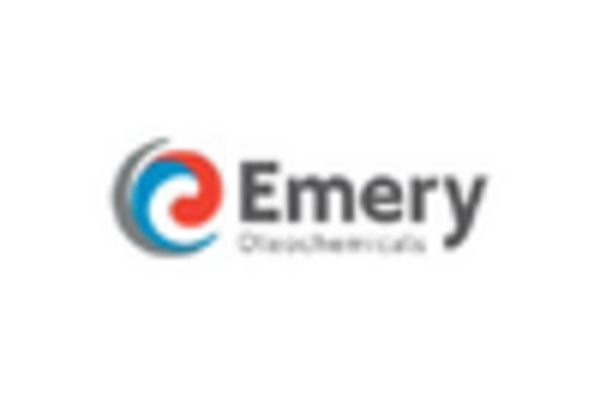Rising Demand in Food Industry
The Stearyl Alcohol Market is also benefiting from its applications in the food sector, where it is used as an emulsifier and stabilizer in various food products. The food industry is witnessing a shift towards cleaner labels and natural ingredients, which may lead to an increased acceptance of stearyl alcohol in food formulations. The Stearyl Alcohol Market is expected to grow at a CAGR of approximately 6% in the coming years, indicating a potential rise in demand for stearyl alcohol as a food additive. This trend reflects a broader consumer preference for products that are perceived as healthier and more natural. As food manufacturers adapt to these changing consumer demands, the role of stearyl alcohol in enhancing product quality and stability is likely to become more pronounced within the Stearyl Alcohol Market.
Growth in the Pharmaceutical Sector
The Stearyl Alcohol Market is poised for growth, particularly due to its applications in the pharmaceutical sector. Stearyl alcohol is utilized as a stabilizer and emulsifier in various medicinal formulations, including ointments and creams. The pharmaceutical industry has been expanding, with a projected growth rate of around 4% annually, which could lead to increased demand for stearyl alcohol as a key ingredient. This growth is driven by the rising prevalence of chronic diseases and the need for effective topical treatments. As pharmaceutical companies continue to innovate and develop new formulations, the reliance on stearyl alcohol is likely to increase, thereby enhancing its market presence. The intersection of pharmaceutical advancements and the properties of stearyl alcohol suggests a promising outlook for the Stearyl Alcohol Market.
Technological Advancements in Production
Technological advancements in the production of stearyl alcohol are likely to play a crucial role in shaping the Stearyl Alcohol Market. Innovations in manufacturing processes, such as the development of more efficient extraction and purification techniques, could lead to reduced production costs and improved product quality. These advancements may enable manufacturers to meet the growing demand for stearyl alcohol across various sectors, including cosmetics, pharmaceuticals, and food. Furthermore, the integration of sustainable practices in production processes could enhance the appeal of stearyl alcohol, aligning with consumer preferences for environmentally friendly products. As technology continues to evolve, the Stearyl Alcohol Market may witness a transformation that not only boosts supply but also enhances the overall market dynamics.
Expanding Applications in Industrial Sectors
The Stearyl Alcohol Market is experiencing diversification in its applications across various industrial sectors. Beyond personal care and pharmaceuticals, stearyl alcohol is increasingly utilized in the production of lubricants, coatings, and plastics. The industrial lubricants market is projected to grow at a CAGR of around 3% in the upcoming years, which could drive demand for stearyl alcohol as a key ingredient in formulations that require enhanced performance and stability. This expansion into industrial applications suggests a broader recognition of the versatility of stearyl alcohol, potentially leading to increased market penetration. As industries seek high-performance materials, the role of stearyl alcohol in enhancing product efficacy and durability is likely to become more prominent within the Stearyl Alcohol Market.
Increasing Application in Personal Care Products
The Stearyl Alcohol Market is experiencing a notable surge in demand due to its extensive application in personal care products. This compound serves as an emollient, emulsifier, and thickening agent, making it a preferred choice in formulations for creams, lotions, and hair conditioners. The personal care sector is projected to grow at a compound annual growth rate (CAGR) of approximately 5% over the next few years, which is likely to bolster the demand for stearyl alcohol. As consumers increasingly seek products that enhance skin and hair health, the incorporation of stearyl alcohol in formulations appears to be a strategic move for manufacturers aiming to meet evolving consumer preferences. This trend indicates a robust growth trajectory for the Stearyl Alcohol Market, driven by the rising popularity of personal care items that prioritize quality and efficacy.


















Leave a Comment